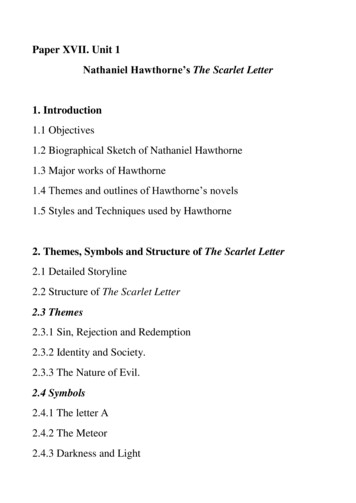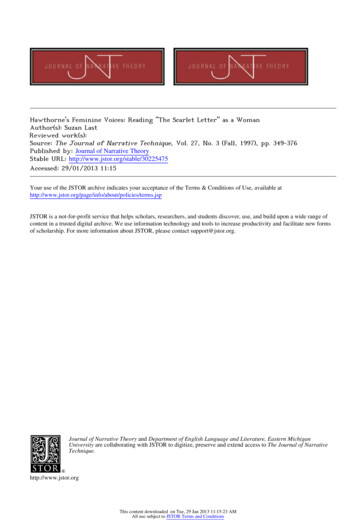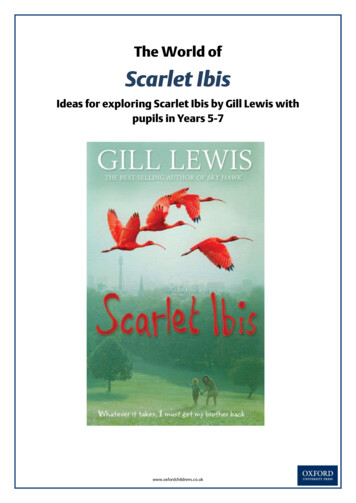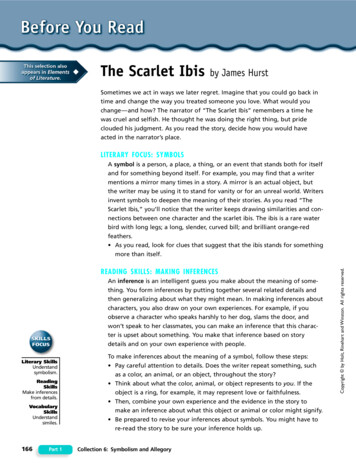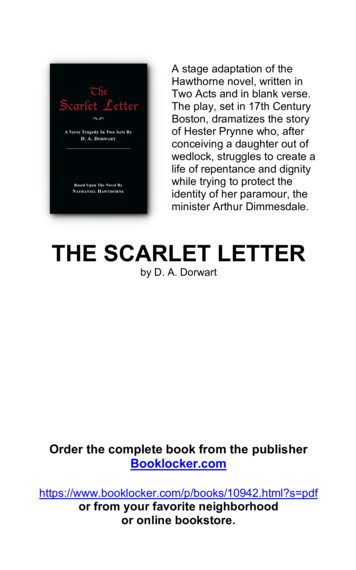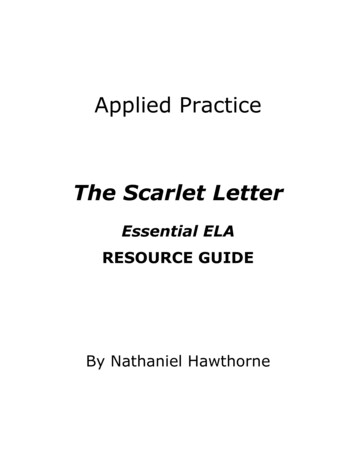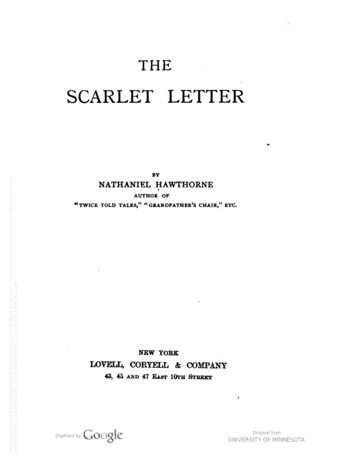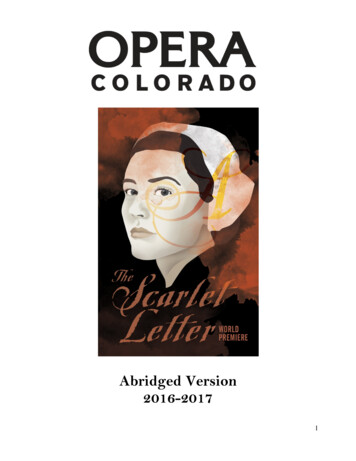
Transcription
Abridged Version2016-20171
A Letter to the TeachersDear Teachers,Opera Colorado is pleased to provide engaging educational programs and performances forstudents across Colorado. What follows is a guide that we hope you and your students find useful, aswe explore Lori Laitman’s The Scarlet Letter. In the spirit of exploration, we have included variouslessons that connect The Scarlet Letter with different subjects of learning. The lessons reference thenew Colorado Department of Education’s Academic Standards: specifically, focusing on the fourthgrade expectations. This does not mean, however, that these lessons should be limited to this agegroup. While we would be very pleased if you used these lessons in the exact format provided, weencourage you to expand, alter, and adapt these lessons so that they best fit your students’ abilitiesand development. After all, the teacher knows their student’s needs best. We would appreciate yourfeedback on our teacher evaluation form found at the end of this guide, and we hope that you enjoyall that Opera Colorado has to offer!Thank you!- Cherity Koepke Director of Education & Community Engagement- Parisa Zaeri Education & Community Engagement Assistant2
Contact us to learn more!Opera Colorado’s Education & Community Programs department offers many more programs toassist your students as they continue to discover the world of opera. We have programs that takeplace at the Ellie Caulkins Opera House as well as programs that we can bring directly to yourclassroom. We even have opera education specialists that can teach lessons directly to yourstudents.Cherity Koepke, Director of Education & Community Engagementckoepke@operacolorado.org, 303.778.0371Parisa Zaeri, Education & Community Engagement Assistantpzaeri@operacolorado.org, 303.778.7350Opera Colorado695 S. Colorado Blvd.,Suite 20Denver, CO 80246Opera Colorado makes every effort to ensure that the information provided in this guidebook is as accurate as possible.With the exception of materials used for educational purposes, none of the contents of this guidebook may be reprintedwithout the permission of Opera Colorado’s Education & Community Programs department. Dictionary definitionswere taken from www.Merriam-Webster.com, and unless marked otherwise, educational information was gathered fromwww.Wikipedia.com . Unless otherwise noted, the materials in the Scarlet Letter guidebook were developed andcompiled by Opera Colorado administrative staff: Cherity Koepke and Parisa Zaeri.3
Table of ContentsSynopsis of Production .5Meet the Composer . 8Meet the Librettists. 9Meet the Novelist . 10Introduction to Opera . 11Activity: Diagramming Differences . 12Activity: Compare and Contrast . 15Activity: Storyline Analysis . 16Activity: Visual Arts .21Activity: Creative Writing. 24Activity: Logic Puzzle. 26Discussion: Gender Roles & Societal Oppression .28Activities: Gender Equality and The Scarlet Letter .29Discussion: Gender Equality in the Media .37Dialogue Starters for Discussing Bullying 39Additional Resources .40Activity: Word Search . .41Opera Broadcasts on CPR Classical 88.1. .42Evaluation. .434
The Scarlet LetterComposed by Lori LaitmanLibretto by David MasonAdapted from Nathaniel Hawthorne’s novel The Scarlet LetterProfessional Debut- May 7, 2016Opera Colorado, The Ellie Caulkins Opera HouseCast of CharactersRoleVoice TypePlayed ByHester Prynne, a youngpuritan womanRev. Arthur Dimmesdale, ayoung ministerRoger Chillingworth adoctorMistress Hibbons, a witchSopranoLaura ClaycombTenorDominic ArmstrongBaritoneMalcom MacKenzieMezzo-sopranoMargaret GawrysiakJohn Wilson, an elderministerGovernor BellinghamTenorKyle Erdos-SmithBaritoneDaniel BelcherPearl, Hester’s YoungDaughterChorus, PuritansNon-singing roleA SailorBaritoneCharles EatonA FarmerTenorBen WerleyA ShipmasterBaritoneWilliam BryanGoodwife 1SopranoEmily RobinsonGoodwife 2SopranoBecky BradleyGoodwife 3Mezzo-sopranoDanielle LombardiThe LeaderBaritoneWilliam BryanThe BeadleNon-singing role5
A World Premiere Production for Opera ColoradoMusic by Lori LaitmanLibretto by David MasonWorld Premiere: May 7, 2015ACT IScene 1. A Meeting Place."One law. One law. One law. One," chants Boston's Puritan community in the opening trial scene.The public environment is cold, unforgiving and filled with fear. A tense crowd awaits the arrivaland sentencing of the adulteress Hester Prynne. So shocking is the image of a young womancradling her infant, standing isolated while awaiting judgment, that it is seared into ourimaginations.The young Reverend Dimmesdale is chosen to interrogate Hester. He's the unknown father ofHester's child but lacks the courage to confess it publicly. This struggle sparks his descent intomadness.Hester is forced to wear the scarlet letter 'A' on her breast for the rest of her life.Newly arrived on the scene is Hester's husband, Dr. Chillingworth, who had been missing for twoyears. He sets out on his own obsessive course to identify his wife's lover.Scene 2. The Jail.We discover Hester in prison, a dark and claustrophobic space. She is attempting to nurse her babyback to health. Dr. Chillingworth visits and heals the child. The two agree to hold the secrets oftheir past life together, but the Doctor insists on knowing the identity of Pearl's father. Hesterrefuses.The Doctor leaves in a rage.Scene 2a. The Passage of Time.The community sings of their devotion to God and marvel that only he knows the answer. Thespace is mysterious and infinite. It is unanchored.Scene 3. The Governor's Garden.This is a rose garden of thorns and blood. The community's Elders want to separate Hester andPearl, to violate the natural blood bond between mother and child. The Reverend intercedes onHester's behalf, leaving the Elders stunned.6
Scene 4. The Reverend's Study. His Nightmare.A calm and orderly library has turned into a tortured environment: books, empty medicine bottles,blankets and pillows are strewn everywhere. The years of guilt have clouded the Reverend's mindand also weakened his heart. His conflicts remain unresolved. Reality is beginning to slip awayfrom him as he hallucinates and returns to the scene of Hester's punishment. He sees visions of 'A'in the skies. He is further taunted by a witch who knows his secret. He's desperate to confess thetruth, but cannot. He grows sicker.ACT IIScene 1. The New England Forest.It is here, in the wilderness outside of the town, and here under the protective forest canopy, thatthe lovers can finally meet. The scene is open and optimistic; even romantic. The narrowness andharshness of Puritan life has been temporarily lifted. Hester and the Reverend can breathe for thefirst time in years, and Dimmesdale can finally acknowledge his daughter. At Hester's urging, thefamily plans to escape the town. But clouds begin to crowd the scene as the Reverend learns thetrue identity of Dr. Chillingworth.Scene 2. A Meeting Place. Election Day.The mood is festive and bright. The town has grown and rejoices in its communal strength. Hesterhas booked their escape by ship. The Reverend begins to deliver his holiday sermon but his mindstarts to wander. The public is stunned. He takes Hester and Pearl onto the scaffold and at themoment of his confession, he dies. The scene ends with a small circle of intense light on the unitedfamily.EpilogueWe now move into a completely abstracted space where the stage is time. The drama acceleratesand cycles through different reflective moods. At first the community mourns the Reverend'sdeath; then Hester looks back on her own life. Finally the community -- in the same present timeas the actual audience -- comments on these lives as legend. Past and present are joined at theconclusion of the opera. Property of Opera Colorado reprinted by written permission only.7
istian SteinerThe Composer: Lori LaitmanCom-po-ser: One that composes; especially, one who writes musicLori Laitman is one of America’s most prolific and widely performedcomposers of vocal music. She has composed two operas, an oratorio,choral works, and over 200 songs. She has set the words of classical andcontemporary poets, many among them the lost voices of poets whoperished in the Holocaust. The Journal of Singing has written: “It isdifficult to think of anyone before the public today who equals herexceptional gifts for embracing a poetic text and giving it new and deeperlife through music.”The Scarlet Letter, Laitman’s full-length opera, will receive itsprofessional world premiere at Opera Colorado in Denver in May 2016. The libretto, basedon the Hawthorne classic, is by American poet David Mason, the current poet laureate ofColorado. Laitman’s oratorio Vedem, another collaboration with Mason, was commissionedby Music of Remembrance and saw its world premiere in Seattle in May 2010. Naxosreleased a CD of the work in May 2011, about which Fanfare Magazine wrote: “A mosttouching experience and one that further confirms Laitman’s status as one of the mosttalented and intriguing of living composers.” Laitman and Mason are currentlydeveloping Ludlow, a new opera based on Mason’s award-winning verse novel about the1914 Colorado mining town disaster. Excerpts will be presented at The University ofColorado’s New Opera Workshop in June 2012.Laitman graduated magna cum laude from Yale College and received her Master of Musicdegree from The Yale School of Music. For more information, please visit artsongs.com.
The Librettist: David MasonLi-bret-tist: Writer of the text of a work (as an opera) for the musical theater.David Mason's books of poems include The BuriedHouses (winner of the Nicholas Roerich Poetry Prize), TheCountry I Remember (winner of the Alice Fay Di CastagnolaAward), and Arrivals. His verse novel, Ludlow, was publishedin 2007, and named best poetry book of the year by theContemporary Poetry Review and the National Cowboy andWestern Heritage Museum. It was also featured on the PBSNews Hour. He is also author of a collection of essays, ThePoetry of Life and the Life of Poetry, and his memoir, Newsfrom the Village, appeared in 2010. Mason has co-editedseveral textbooks and anthologies, including: Western Wind:An Introduction to Poetry; Rebel Angels: 25 Poets of the NewFormalism, Twentieth Century American Poetry, andTwentieth Century American Poetics: Poets on the Art ofPoetry V. His poetry, prose and translations have appeared insuch periodicals as the New Yorker, Harper's, the Nation, theNew Republic, the New York Times, the Times Literary Supplement, Poetry, Agenda, ModernPoetry in Translation, the New Criterion, the Yale Review, the Hudson Review, the AmericanScholar, the Irish Times, and the Southern Review. Mason has also written the libretti forcomposer Lori Laitman's opera of The Scarlet Letter and her Holocaust oratorio, Vedem. In2009 he won the Thatcher Hoffman Smith Creativity in Motion Prize, allowing him toadapt Ludlow into a new libretto for Laitman. A former Fulbright Fellow to Greece, Masonwas recently named Poet Laureate of Colorado. Click here to listen to Mason's interview withColorado Public Radio, or go to rados-new-poet-laureate.9
The Novelist: Nathaniel HawthorneNo-vel-ist: Writer of the text of a workNathaniel Hawthorne (July 4, 1804 – May 19, 1864):American novelist and short story writer.Nathaniel Hawthorne was born in the city of Salem,Massachusetts to Nathaniel Hathorne and Elizabeth ClarkeManning. His ancestors include John Hathorne, the onlyjudge involved in the Salem witch trials who never repentedof his actions. Nathaniel later added a "w" to make his name"Hawthorne" in order to hide this relation. He enteredBowdoin College in 1821, was elected to Phi Beta Kappa in1824, and graduated in 1825. Hawthorne anonymously published his first work, a novel titledFanshawe, in 1828. He published several short stories in various periodicals which hecollected in 1837 as Twice-Told Tales. The next year, he became engaged to SophiaPeabody. He worked at the Custom House publishing company and joined Brook Farm, atranscendentalist community, before marrying Peabody in 1842. The couple moved to TheOld Manse in Concord, Massachusetts, later moving to Salem, the Berkshires, and then toThe Wayside in Concord. The Scarlet Letter was published in 1850, followed by a successionof other novels. A political appointment took Hawthorne and family to Europe before theirreturn to The Wayside in 1860. Hawthorne died on May 19, 1864, and was survived by hiswife and their three children.Much of Hawthorne's writing centers on New England, many works featuring moralallegories with a Puritan inspiration. His fiction works are considered part of the Romanticmovement and, more specifically, dark romanticism. His themes often center on the inherentevil and sin of humanity, and his works often have moral messages and deep psychologicalcomplexity. His published works include novels, short stories, and a biography of his friendFranklin Pierce.NovelsFanshawe (1828)The Scarlet Letter (1850)The House of Seven Gables (1851)The Bithedale Romance (1852)The Marble Faun: Or, The Romance of Monte Beni (1860)The Dolliver Romance (1863) (unfinished)Septimus Felton; or, the Elizir of Life (published in the Atlantic Monthly, 1872)Doctor Grimshawe’s Secret: A Romance (unfinished) (1881)10
Introduction to OperaWhat do you think of when you hear the term “Opera”? Do you think of people in funnyhats with horns, or of singing that’s very loud and hard to understand?While you have probably moved beyond this point, most students are familiar only withthese opera stereotypes. The goal of this first exercise is to help students recognizestereotypes about opera and to move on to a greater understanding and appreciationfor the art form.In other words, to help students move from this:To this:11
Diagramming DifferencesInstructor GuideSupplies:- Large sheets of butcher paper- Colored pencils or markersDirections:- Have students break into groups of 4 or 5.Instruct them to work together to draw whatthey think on opera singer looks like. Encouragethem to be as detailed as possible.- Give students 20 to 30 minutes to work on theirpictures- When they’re done, have the students explain their choices to the rest of theclassDiscussion:- Start out with a brief definition of what a stereotype is (an oversimplifiedstandardized image of a person or group). Ask the students to identify anystereotypes in their drawings. Write these on the board.- Next, go back through the list and write down the truth behind each stereotype(for example, if students thought that opera singers are all old, write down thatopera singers can be both young and old).Additional Activities:- Have the students make their own T chart compiling the two lists of stereotypesand realities.- Have the students write a short paragraph summarizing what they’ve learned.- Have the students identify stereotypes in another area they’ve been studying(maybe a story they’ve been reading in class or a topic from history) and create aT chart for it.Example:StereotypeReality- Opera is for old people- Opera is for everyone- Operas have to be serious- Operas can be both tragic and comedic- Opera singers dress likeVikings- Operas were written a longtime ago- Opera singers dress according to thetime period of the opera- Operas are still being written today12
Activity: Compare and Contrast!While the opera is more rich and varied than it is often given credit for, it isstill a distinct musical form. As you’ve probably guessed.Opera and pop music aregenres with many differences! Singers such as Renee Fleming, Denyce Graves andJoan Sutherland are much different than pop singers such as Miley Cirus and TaylorSwift. In this activity, we will listen to different examples of famous opera excerptsand famous pop songs. Can you spot the differences?EXAMPLE #1:“Wildest Dreams”by Taylor Swifthttps://www.youtube.com/watch?v IdneKLhsWOQEXAMPLE #2:“Sempre Libera”(Always Free)by Giuseppe Verdisung by Natalie Dessayhttps://youtu.be/5HDKgsXfkaA?t 2m44sTranslation: one-always-free.html13
Activity: Compare and ContrastInstructor GuideIntroductionIf time permits, let your students enjoy each song in its entirety. (Make sure they are takingnotes on the differences between Taylor Swift’s “Wildest Dreams” and the aria “SempreLibera” from Verdi’s opera La traviata.)LessonUsing their individual notes, have the class break into small groups. Give the groups 5 to 10minutes to discuss the differences they are noting.After small group discussions, hand out the attached worksheet, and give students another 10minutes to fill them out individually. Musicians must keep keen ears, and noting differencesin instrumentation, language, and style/genre of music is critical for any performer,musicologist or critic. Suggest these factors to students who may be having trouble on theirworksheets.Recommended musical factors to cover:1.) Foruma.) Live or recorded?b.) Microphone or no microphone?c.) Types of audiences?2.) Languagea.) Italian vs. Englishb.) Are operas and popular songs written in otherlanguages?3.) Instrumentationa.) Electric or acoustic?b.) Differences in singing: is it speech-like or not?c.) Concert hall vs. a recording studioConclusionListen to each song once again, and then have a class discussion, giving students time tofinish their worksheets and share their ideas.14
Name:Compare and ContrastPop and Opera Worksheet1.) After your first listening, what do you notice that is similar between each song?2.) After your fist listening, what do you notice that is different between each song?3.) Notes from small group discussion.4.) After your second hearing, what do you notice is different concerning language,instruments used, and performance setting?5.) Notes from class discussion.6.) Which piece of music do you like better? Use evidence from what you are hearing toback up your answer.15
Name:Activity: Storyline AnalysisCut out the following scenes from The Scarlet Letter from the paper below and paste themonto the following page.Definitions:Exposition: Beginning of the story where the characters and setting areintroducedRising Action: Conflict arises that the characters must confrontClimax: The final confrontation between the characters and the conflict,the turning pointFalling Action: The actions that occur as a direct result of the turning pointResolution: When all the actions are complete and the story draws to a (Denouement)conclusion Dimmesdale & Hester realize Chillingworth will followthem wherever they flee in order to gain revenge.Chillingworth confrontsHester in her jail cell.Hester is shunned by thecommunity but is looked afterby Dimmesdale.Dimmesdale tells the community he loves Hester.Dimmesdale grows ill – Chillingworthmoves in to care for him.Dimmesdale diesfrom his illness.Hester refuses to reveal the name of her child’s father.Chillingworth figures out that Dimmesdalewas Hester’s lover. Hester asks him not to telland warns Dimmesdale.Dimmesdale tries to punishhimself for his sins.Dimmesdale and Hester plan to leave town, butChillingworth learns of their plans.Hester is judged at the scaffold.16
Activity: Storyline Analysis ContinuedWho are the main characters?Where does the story take place?When does the story take place?Cut and paste the parts of The Scarlet Letter into the diagram of the story structureClimaxConclusionRising ActionThe 5 C’s of a Good lusion17
Story Analysis Worksheet Instructor GuideWho are the main characters?Where does the story take place?When does the story take place?Cut and paste the parts of The Scarlet Letter into the diagram of the story structureClimaxDimmesdale tells the community he loves Hester.Dimmesdale diesfrom his illness.Dimmesdale & Hester realize Chillingworth will followthem wherever they flee in order to gain revenge.Dimmesdale and Hester plan to leave town, butChillingworth learns of their plans.Dimmesdale grows ill – Chillingworthmoves in to care for himChillingworth figures out that Dimmesdalewas Hester’s lover. Hester asks him not to telland warns Dimmesdale.Rising ActionChillingworth confrontsHester in her jail cell.Hester is shunned by thecommunity but is looked afterby Dimmesdale.The 5 C’s of a Good Story!Dimmesdale tries to punishhimself for his usionHester refuses to reveal the name of her child’s father.Hester is judged at the scaffold.18
Activity: Storyline Analysis(Alternate Activity)If you’re looking for passion and intrigue, romance, mystery, and tragedy, it doesn’t getmuch better than The Scarlet Letter. Using the worksheet on the following page, havestudents choose five scenes from the opera – one that illustrates each part of the story(exposition, rising action, climax, falling action, resolution). Draw a picture of the scene,than summarize it on the side of the paper.The 5 C’s of a Good nitions:Exposition–Beginning of the story where the characters and setting areintroducedRising Action – Conflict arises that the characters must confrontClimax– The final confrontation between the characters and the conflict,the turning pointFalling Action – The actions that occur as a direct result of the turning pointResolution– When all the actions are complete and the story draws to a(Denouement)conclusion19
Activity: Storyline AnalysisExpositionRising ActionClimaxFalling ActionResolution20
Activity: Visual ArtsSet design is a pivotal part of any opera production. The set provides the context andbackground for the story and each character that makes up the story. Certain designers anddirectors prefer simple sets, which puts more emphasis on the opera singers themselves asseen below in Opera Colorado’s 2016 production of The Scarlet Letter. Other directors anddesigners create grandiose scenes with large sets and a large chorus of singers.21
Design Your Own SetDirections: Set design teams (along with directors) not only establish their vision of whatthey want in the scene, but what color the lights will be and where the singers will be placed.Using what you know about The Scarlet Letter, choose a scene to create a set for. Thinkabout what items will need to be placed where and what color schemes you can use toenhance the quality of the performance.22
Activity: Visual ArtsInstructor GuideIntroductionHand out a worksheet (on previous page) to each student and read theintroductory paragraph on set design. If time permits, you may wish to show the studentspictures of different opera sets. Links can be found site36/2011/0428/20110428 ae29cind3 s.com/uploadedImages/Opera News dl1511.jpghttp://www.operanews.com/ nAllow the students 20-30 minutes to design their sets. Encourage them to be as creative andas detailed as possible. The set should also tell a story, and should reflect what is going on inthe opera.When they are finished, bring the class back together. Ask for volunteers to describe theirdrawings. Encourage the students to explain why they made the choices they did. The goal ofthis project is to allow students to see all of the thought and planning that go into set designs.Recommended discussion questions1.) Settinga.) Is the scene inside or outside? Can you tell what types of people might inhabit thatspace by looking at it (rich or poor, workers, a king, a family)?b.) What props and backdrops are necessary to convey a sense of place?2.) Colora.) What colors were used?b.) How does color and lighting affect the mood of the scene?3.) Planninga.) Was it difficult to include everything in the amount of space given?b.) What problems would set designers face in having to create a set for a big theater(directing audience attention to the appropriate spot, time of making such big sets)?What problems would designers face in having to create a set for a little theater(consolidation, utilizing every inch, not making it too crowded).Additional ActivitiesSet design can also be a fun way to teach math skills. For an additional challenge, try placing certainparameters on what the students can draw (ex. There must be a building 3 cm high and 2 cm wide,there must be a prop 7 cm from the left side of the stage and 3 cm from the bottom).23
Activity: Creative WritingWhen writing a story, an author has to consider many things. Like a good detective, anauthor must consider who, what, when, where, and why – who the characters are, what theplot line is, when and where the story takes place, and why the characters behave the waythey do (or, in other words, the setting, characters, conflict, and resolution). In this exercise,students will practice manipulating the setting and characters of the 7642905/7-24-1224
Name:Activity: Creative WritingWorksheetThe Scarlet Letter takes place near Boston, Massachusetts in 1642. Imagine instead that ittook place in America today. Think about the various details of the plat and setting thatwould have to change. For example: Where would Hester be from? What kind of job wouldDimmesdale have? Where would they live? How could you rewrite the characters and settingin The Scarlet Letter to be contemporary while still making sure that the conflict andresolution make sense? Use the space below to outline your thoughts.Outline:25
Activity: Logic PuzzlesInstructor GuideThis activity is a great addition to any math lesson. It emphasizes logic and reasoning, whilesimultaneously encouraging students to read critically. The worksheet also includes a briefexplanation about Puritanism in early America.Topics of Discussion1. American history2. Probability, logic, and reasoning.Instructions:1.2.3.4.As a class, read the handout on the Puritans.Answer any questions the students might have.Give the students time to complete the worksheet.Use the key provided below to check answers.Additional Activities1. The information on the Puritans could also be used to launch further discussion onAmerican history and culture, or of history and culture in general.2. The math worksheet would be a good way to warm up at the beginning of a mathclass, or as a filler between subjects.Key: Green signifies the correct answerPreaching ReadingCookingDoingLaundryHouse 1House 2House 3House 4WilliamMaryJacobAnneHouse 1House 2House 3House 426
Name:Activity: Logic PuzzlesDirections: Use the clues below to figure out which Puritan iscompleting which job, and which house they are in. Shade in thecorrect answers completely, and mark an X in all of the other boxes.PreachingReadingCookingDoingLaundryHouse 1House 2 House 3 House 4WilliamMaryJacobAnneHouse 1House 2House 3House 4Clues:1. William is not doing laundry.2. Cooking, which is Jacob’s favorite activity, is not being done inan even numbered house.3. Anne’s activity is taking place in House 2.4. Mary dislikes reading.5. House 4 wasn’t suitable for preaching, so it was moved twohouses to the left.6. Anne is preaching.7. The house that the cooking is taking place in is only divisible byone.8. The activity that William is doing is in the house number thatequals 2x2.27
Gender Roles and Social Pressurein The Scarlet LetterInstructor GuideThe story of the The Scarlet Letter is more than a story about extremist Puritan ideology and beliefson adultery. First and foremost, it is about the strength shown by Hester Prynne: her courage andwillingness to forgive; to move towards improving her life after suffering tragedy; and her resolve tostay true to herself despite the judgment shown to her community. Students will be able to relate tothe lesson about following your own path and remaining true to your conscience, even when othersdisagree.The Scarlet Letter is also a story about the actions of those in power and how they sometimesencourage societal oppression. In today’s society, where social media can be used as a tool forwidespread public denunciation and humiliation, The Scarlet Letter carries a message as strongly as itdid in 1850. These next few activities will help you explore the topics of gender equality, socie
The Scarlet Letter, Laitman’s full-length opera, will receive its professional world premiere at Opera Colorado in Denver in May 2016. The libretto, based on the Hawthorne classic, is by American poet David Mason, the current poet laureate of Colorado. Laitman’s oratorio


